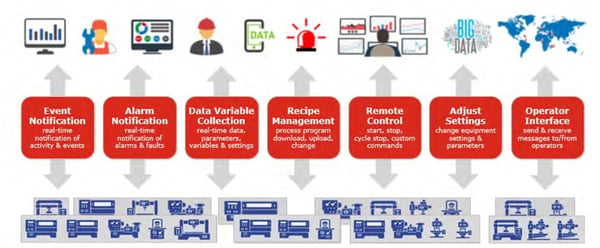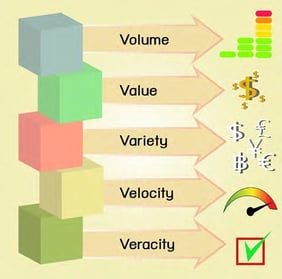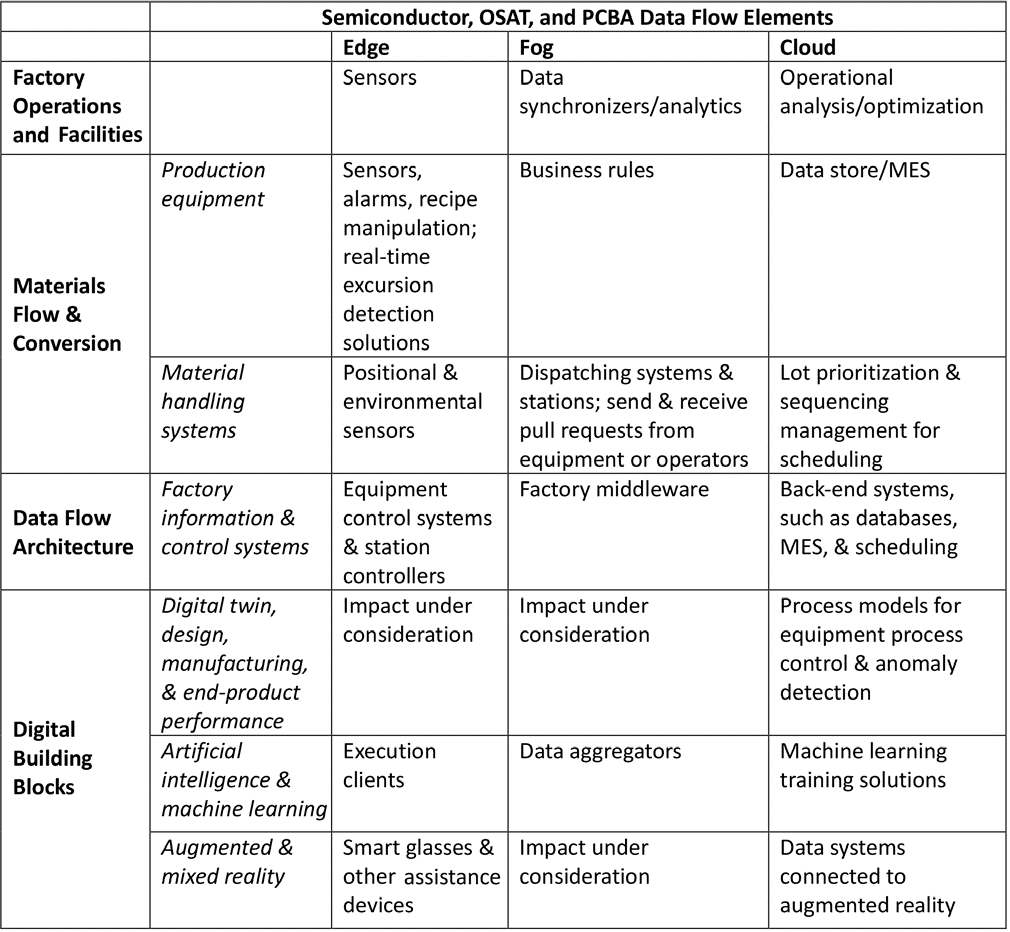Smart Manufacturing Roadmap: Data Flow Considerations for the Electronics Manufacturing Industry
Published in July issue of SMT007. Click here for full PDF
Article by Ranjan Chatterjee and Dan Gamota
The 2019 iNEMI Roadmap features a new chapter on smart manufacturing. The chapter identifies key technology gaps and needs and offers recommendations to guide the electronics manufacturing industry in realizing the benefits of smart manufacturing. This article is based on information excerpted from the chapter.
The future of the electronics manufacturing industry depends on its ability to develop and deploy suites of technology platforms to realize the benefits of smart manufacturing and Indus- try 4.0. Smart manufacturing technologies will improve efficiency, safety, and productiv- ity by incorporating more data collection and analysis systems to create a virtual business model covering all aspects from supply chain to manufacturing to customer experience. The increased use of big data analytics and artificial intelligence (AI) enables more efficient collec- tion and analysis of large volumes of data.
Several industry reports predict that manufacturers will realize tens of billions of dollars in gains by 2022 after deploying smart manufacturing solutions. R&D programs around the world are developing technologies that will improve traceability and visualization, enable real-time analytics for predictive process and machine control, and build flexible, modular manufacturing equipment platforms for high- mix, low-volume product assembly.
The vertical segments of the electron- ics manufacturing industry—semiconductor devices, outsourced semiconductor assem- bly and test (OSAT), and printed circuit board assembly (PCBA)—are converging, and service offerings are being consolidated, driven by common/shared challenges, such as:
• Responding to rapidly changing, complex business requirements
• Managing increasing factory complexity
• Achieving financial growth targets while margins are declining
• Meeting factory and equipment reliability, capability, productivity, and cost requirements
• Leveraging factory integration technologies across industry segment boundaries
• Meeting the flexibility, extendibility, and scalability needs of a leading-edge factory
• Increasing global restrictions on environmental issues
• Materials flow and conversion
• Data flow architecture
• Digital building blocks (artificial intelli- gence, machine learning, digital twin)
• Security
This article focuses on the data flow architecture of smart manufacturing, the foundations of which are:
• Factory information and control systems
• Big data
• Edge, fog, and cloud computing
It highlights the roadmap’s integration of these elements across factory operations and facilities, digital building blocks, and security for semiconductor, OSAT, and PCBA manufacturing.
Situation Analysis
General factory operations and manufac- turing technologies (i.e., process, test, and inspection) and the supporting hardware and software are evolving quickly while the abil- ity to transmit and store an increasing volume of data for analytics—such as AI, machine learning (ML), and predictive (versus reactive) operations—is accelerating.
The advent, and subsequent growth, of big data is occurring faster than originally antic- ipated. This trend will continue, highlight- ing existing challenges and introducing new gaps that were not considered previously. The roadmap identifies several key considerations for data flow. It should be noted that while there are common elements across the three electronics manufacturing vertical segments (semiconductor, OSAT, and PCBA), there are also unique situations specific to each manu- facturing environment. In all cases, standard- ized communication interfaces between the segments are critical.
Semiconductor and OSAT
For semiconductor device manufacturing and back-end assembly and test, accelerating the development of big data technologies will enable the deployment of solutions to real- ize benefits from increases in data generation, storage, and use. These capabilities, which deliver higher data volumes at real-time and near-real-time rates, will increase the availabil- ity of equipment parameter data to positively impact yield and quality. There are several challenges and potential solutions associated with these changes, including:
• Connectivity architecture providing smart manufacturing functionality (Figure 1)

• Data flow between manufacturing execution systems (MES)—fog or cloud— and machine interfaces (edge)
• Security of information transmitted between and across the cloud to remote access points
• Standardization/guidelines for data formats between edge devices (e.g., machine-to-machine (M2M) communication)
• Preferred options for real-time monitoring and response time (e.g., M2M versus machine-to-MES, edge to fog) Printed Circuit Board Assembly (PCBA)
Printed Circuit Board Assembly (PCBA)
The PCBA segment is in alignment with the semiconductor and OSAT verticals. The primary topics to address are data quality and incorporating subject-matter expertise in analytics to realize effective online manufac- turing solutions.
The emergence of big data in electronics manufacturing operations should be discussed in terms of the “5Vs Framework,” which is as follows and shown in Figure 2:
1. Volume
2. Velocity
3. Variety (data merging)
4. Veracity (data quality)
5. Value (application of analytics)
The majority of subject-matter experts (semiconductor, OSAT, and PCBA) stress that robust and redundant architectures for data flow must be established to benefit from the 5Vs attributes.
Data volumes in factories are growing at exponential rates. Pervasive data velocities measured as the data collection rates from equipment increased from less than 1 Hz in the 1990s to 10 Hz today, and are projected to be at 100 Hz in a few years. Data from equipment, maintenance, yield, inventory management, MES, and enterprise resource planning (ERP) existed for several years; however, analyt- ics tools have evolved to leverage and merge multiple data sources to explore relationships, detect anomalies, and predict events. The 5Vs are foundational to appreciate widespread adoption of big data analytics in the electron- ics industry. It is critical to address the iden- tified gaps—such as accuracy, completeness, context richness, availability, and archival length—to improve data quality to support advanced analytics for the electronics manu- facturing industry [1].
Quantified Key Attribute Needs
The development of a scalable architecture that provides flexibility to expand; connect across the edge, fog, and cloud; and integrate a variety of devices and systems generating data flow streams is critical. Different indus- tries seeking to deploy smart manufacturing technologies should leverage architectures that provide the desired attributes, and data flow architecture is generally considered a prime candidate for leveraging and cross-industry collaboration to identify the optimum solution.

Table 1a: Key attribute needs, data flow considerations within and between electronics industry manufacturing segments.

Table 1b: Key attribute needs, security data flow considerations within and between electronics industry manufac- turing segments.
Semiconductor
The development and deployment of tech- nologies for data flow are accelerating while data analytics and data retention protocols are increasing at a faster rate than first anticipated. It is critical to collect the crucial data as well as establish guidelines to perform intelligent anal- ysis and exercise the appropriate algorithms to specify data-driven decisions. Several topics related to data are under consideration:
• General Protocols
1. “All” versus “anomaly” data retention practices
2. Optimization of data storage volumes
3. Data format guidelines for analytics to drive reactive and predictive technologies
4. Data quality protocols enabling improve- ments in time synchronization, compression/uncompression, and blending/merging
5. Guidelines to optimize data collecting, transferring, storing, and analyzing
• Data Considerations for Equipment
1. Defining context data sets for equipment visibility
2. Improving data accessibility to support functions, such as advanced process control
3. Data-enabled transition from reactive to predictive functionality
4. Data visibility of equipment information (state, health, etc.)
Outsourced Semiconductor Assembly and Test (OSAT)
The key attribute needs for data flow being considered by OSATs include:
• Are the requirements for data flow within the OSAT vertical different from those required between the verticals (semicon- ductor-to-OSAT or OSAT-to-PCBA)?
• Are security requirements for vertical data flow and horizontal data flow similar or different?
• Are the requirements for data flow between being dependent on edge, fog, and cloud on security requirements?
• Are the data flow needs different for an OSAT managing high product mix that are competitive in nature versus an OSAT managing low product mix?
• What are the criteria to determine the value of the cloud at different levels of data flow architecture maturity/deployment?
• If there is a high level of cloud adoption for the ERP, does this drive adoption at machine-level data flow to the cloud?
Printed Circuit Board Assembly (PCBA)
Subject matter experts agree that access to data will be ubiquitous, cross-platform, and on-demand. Data flow will leverage technologies like augmented reality to help survey produc- tion floors for imminent issues, and machine communications will proactively identify and diagnose issues before an instance. The manage- ment of the type of data and assurance that the recipients receive the “appropriate” volume of data is critical.
Collaborative Efforts
The smart manufacturing chapter identified several critical gaps that must be addressed to realize the benefits of smart manufactur- ing and Industry 4.0. Based on the informa- tion gathered during the preparation of the chapter, iNEMI is organizing an initial smart manufacturing collaborative project to address back-end electronic packaging commonality. This project plans to address the cost and inefficiency of unique customization require- ments across the packaging back-end, seek- ing to demonstrate the benefits of back-end commonality by defining key cases/examples (e.g., tray carriers) to address both physical and digital (information) commonality. This project plans to analyze and quantify the bene- fits of improved cycle time, utilization, yield, costs, etc., in a smart manufacturing environ- ment. For additional information, contact info- help@inemi.org.
About iNEMI
The International Electronics Manufactur- ing Initiative (iNEMI) is a not-for-profit, highly efficient R&D consortium of approximately 90 leading electronics manufacturers, suppli- ers, associations, government agencies, and universities. iNEMI is hosting a meeting at SEMICON West July 9 from 10:00 a.m. to noon at the Moscone Convention Center (San Fran- cisco). This meeting will highlight iNEMI’s Roadmap and include a brainstorming session on potential new projects in the areas of back- end commonality (packaging, inspection, test, and more). Brainstorming topics to include advanced packaging, media, tools optimiza- tion, data analytics, etc. Confirmed attendees include Intel, AMD, Rudolph, KNS, Cimetrix, Jabil, ASM, SEMI, and others. SMT007
References
1. Moyne, J., & Iskandar, J. “Big Data Analytics for Smart Manufacturing: Case Studies in Semiconductor Manufacturing,” Processes Journal, Vol. 5, No. 3, July 2017.
Ranjan Chatterjee is vice president and general manager, smart factory solutions, for Cimetrix, and Dan Gamota is vice president, manufacturing technology and inno- vation, for Jabil. They are co-chairs of the new smart manufacturing chapter of the 2019 iNEMI Roadmap, which will go on sale this summer.


